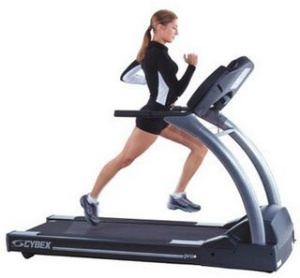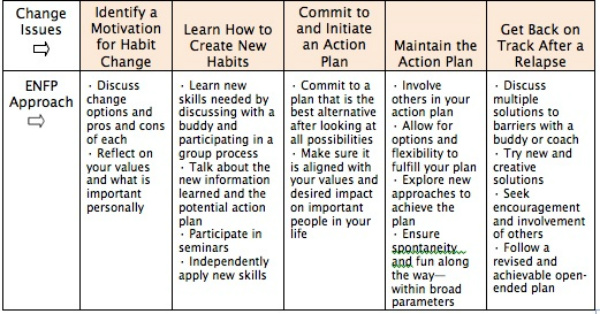
Using Type for Healthy Habits
Liana Lianov, October 4, 2011

I have developed a framework that integrates type preferences with one of the best-known behavior change theories, the stage of change theory, also called the trans-theoretical model (Rollnick, 2002). This new approach offers suggestions for using type preferences to advance one through each stage of change. The stages go from not thinking about making a change, to considering a change, preparing for the change, making the change, and lastly—but most importantly—maintaining that change until it becomes a lifelong healthy habit. Health coaches offer motivational interviewing and other psychological techniques, including cognitive behavioral therapy and positive psychology, to help individuals move through these stages.
This new framework posits that each of the elements of type affects our process of making change—with or without our awareness. It enables us to purposefully harness our type, especially our dominant and auxiliary functions, in the service of making health habit change. We can apply our preference for introversion or extraversion for energy to make the habit change, our preference for sensing or intuition to gather information needed to make the change, our preference for thinking or feeling to decide to change, and our preference for judging or perceiving to arrange life in a way that will successfully accommodate the change. (See also Brue, 2008).
A standard tool that a health coach uses when counseling a patient to develop a new habit is to write an action plan. The plan requires that the specifics of the committed action be outlined: what the patient will do, with whom, where, how often, for how long, and when to check back on progress.
The national physical activity guidelines recommend that we engage in physical activity of a moderate intensity for at least a total of 150 minutes per week. Ronda, who has a judging preference, can develop an action plan which commits her to walking briskly for 30 minutes every work day around the park at lunch with her co-worker Nancy. This traditional action plan may seem reasonable to her. It is easy to put on the calendar and to check off. And it may have the added benefit of keeping her away from the cafeteria where she finds temping treats.
For individuals with a perceiving preference, it is a different story. But they can increase their chance of success with non-traditional action plans that specify the overall goal and list a number of options for achieving that goal. Someone with a perceiving preference needs a flexible plan, preferring to stay open-ended and see what may seem interesting at the time of the activity. Building this flexibility into the plan within broad parameters will increase the chance that the individual will sustain the new habit, because the habit fits her comfort zone.

Fifty-six-year old Linda, a divorced nurse employed in the infection control department of a local hospital, presents for her first health coaching visit. She has a history of high blood pressure and early diabetes. Her doctor has recommended that she lose weight by eating more vegetables, cutting back on carbohydrates and being more physically active. She does not have a regular exercise program and admits to eating out often, especially since her recent move from a house to an apartment where “the kitchen is small and there is no one to cook for anyway.” She also notes that her job has been particularly stressful recently. When she phoned to make the appointment, the coach recommended that she go online and take the MBTI® assessment before the visit. Linda reports as an ENFP and found the type description fit many of her “quirks.”
You, as her health coach and expert in type, ask about Linda’s current health behaviors in more detail and her readiness level to make improvements in each one. Linda was not too sure she could make any diet changes in the near future, saying that she needs her “comfort food, like those delicious empanadas at the restaurant near the hospital, especially now with my current job stress.”
She is thinking of being more physically active in the next month, but has doubts about that as well, since her job leaves her exhausted at the end of the day. She adds “and I am totally a non-morning person! What can I do to break out of this situation? I do not want my diabetes to progress.”
You reassure her that she is making progress by showing up for this appointment and that she does appear ready to increase her physical activity level. You note that as an ENFP, she may be more energized to be active around other people who are also being active. You caution her that interacting with others might be too distracting for her type, but sometimes it can help deter the boredom of exercise. Simply being around others might help encourage her.
“Let’s brainstorm together what kinds of activities you might want to do.”
“I could take a short walk during my break at work around the courtyard, at least on the days I am not covering for another unit. I see some people doing that.”
“Great what else could you do?” [The coach knows that Linda’s dominant function is her extraverted intuition (Ne), which responds to foreseeing several possibilities in the future.]
“I could go walking in the neighborhood on the weekends. I see a couple of neighbors jogging near the apartment complex.”
“Anything else that might be appealing?”
“Actually, I could call my sister to join me. Maybe she can put the baby in the stroller. We could catch up on the family gossip. I hardly get to see her these days.”
“Wonderful. Getting a little better connected with your sister might also help alleviate some of that work stress. I also get the impression that you may not be getting enough time interacting with others and enough social support. As an ENFP, an extraverted type, you might need more time around others to find a sense of energy balance and de-stress.”
“Yes, it has been kind of lonely, since I moved. My sister lived on the next block, but I could no longer afford the house.”
“So it sounds like you are saying this last possibility of walking with your sister might be one you would like to try first. Am I reading that correctly?”
“Yes.”
“Let’s write out your action plan.” [The coach then proceeds to prompt Linda to identify how often and for how long, she will go walking with her sister. The action plan is for Linda to go walking for 45 minutes with her sister Anne every Sunday and also every Wednesday—the day she gets off work early. The savvy coach also realizes that as someone with a perceiving preference, Linda will likely do better if her plan includes a few options.]
“What might you do, if your sister is busy, or if you are just too exhausted from work to see her?”
“Well I could walk in the courtyard during my break the next day. But it would not be nearly as long—maybe 20 minutes.”
“At least you have a back-up plan. Could you go walking at work for two days, if you miss a day with your sister?”
“I can try.”
“Excellent. Now how do you foresee this increased physical activity will affect you? Can you imagine how you will feel?”
“I hope I will feel better and that both my high blood pressure and my early diabetes will be cured!”
“That’s a terrific goal. What other benefits can you picture?”
“Well, of course, I hope to lose weight!”
“Do you see any other benefit?”
“Get asked out on a date!”
“Now we‘re talking! How confident do you feel in this plan on a scale of 1 to 10, one being the least confident and ten being the most confident?”
“Probably seven.”
“That sounds fairly confident. I am hopeful you will come back having achieved your plan. Before I see you next time, I would like for you to spend a little time alone reflecting on your commitment to be more active and lose weight. Reinforce your decision by considering how being active might help you support what you value the most. And although I hear you are not ready to make a change in your eating habits, I would like you to spend a little bit of time on your own to consider what changes you might want to make in your eating habits in the future.” [The coach here is asking Linda to bring out her introverted feeling (Fi) function to make and reinforce her decisions about her habits.]

“Sounds like you have made some good progress. You are certainly being more active than when I first met you. The recent move and work are still getting in the way a bit. What are additional alternatives to help you stay active?”
“Well, I really enjoy walking with my sister. She likes it when I motivate her, and my relationship with her is important to me. She’s a new mom and motherhood is such a precious thing. I am almost completely unpacked now. So I think I can resume my walks with her.” [Linda reflects her introverted feeling function about what she values.]
“Sounds like you would like to stick with the original plan. That’s great.” [Remembering Linda’s ENFP type which gets bored with routine, the coach prods a little further.] “What are your thoughts about meeting her every Wednesday and Sunday? Does that seem feasible? Are there alternatives you might consider?”
“Well, to tell the truth, every Wednesday and Sunday does seem a little daunting and I like having an alternative. But maybe walking at work is not a good option. I suppose that when my sister is busy or we are simply not in the mood to walk together, I can go to the nearby park to walk on my own. I like watching the people there.”
“Yes, being around other people and having some interesting distractions sounds like a good alternative setting for your walks. And keep your eye out for other alternatives. As long as you meet the weekly minimum of 150 minutes of moderate intensity activity, you will improve your health.”
The health action plan of an ENFP needs to include multiple longer-term goals and the immediate short-term action steps to fit with those goals. Fitness and health are a nice side benefit of the action plan but are not likely to be the main driver. An ENFP likes to have fun. Physical activity needs to be interesting, energizing, and challenging, not simply a task. A variety of activities and schedules that allow for spontaneity will also boost her ability to successfully reach her health goals. The plan also needs to help her make connections to people and explore new environments.
During repetitive activities, she can direct her attention to something more entertaining like music or a video. Walking or hiking with others and chatting along the way will distract from the physical activity itself, which can seem tedious. Drop-in fitness classes are great for when the mood strikes. The main guideline is to meet the weekly activity minimum.
When Linda is ready to tackle healthy eating, the savvy coach will help her sustain interest in healthy meals by exploring new healthy recipes that can be shared with others and trying new healthy food items. Cooking and exercise classes to learn with other people can also be educational and motivating for an ENFP; and flexible, health-promoting, fun group activities will likely be sustainable.
In summary, someone with an ENFP type may reach and maintain healthy habits by exploring new and varied methods, as long as the basic recommendations are achieved. The coach can help her get motivated by exploring many possible future impacts, developing a flexible action plan, and problem-solving when barriers arise. The coach also needs to encourage the ENFP to spend time alone to reflect on the decision to make a change and to mentally prepare and reinforce the change by seeing the impact on important values and on the people they care about.
Changing Habits: ENFP Example

The coaching session itself can also be enhanced by knowing and accommodating the client’s type. A coach who is facile with type can help clients conduct behavior change tasks that leverage the dominant or auxiliary extraverted function during the session. She can also encourage the clients to spend time alone to complete change tasks that require the dominant or auxiliary introverted function.
My vision is to introduce these constructs to mainstream health coaching and preventive medicine. We need to conduct research to test this framework and identify effective ways for individuals and counselors to implement it. If you have an interest in joining this movement, please contact me.
References
Brue, S. (2008). The 8 colors of fitness. Delray Beach, FL: Oakledge Press.
Rollnick S., Mason P., & Butler C. (2002) Health behavior change: A guide for practitioners. Edinburgh: Churchill Livingstone.


















What a wonderful article Dr. Lianov! I am an ENFP as well and have been making some of these adjustments towards an action plan already, before seeing your chart. I was experiencing a lot more satisfaction and success than usual, and seeing your example and chart just enhanced my future approach even more. I’ve copied your chart down and then made another with the ENFP approach sections blank, so I can fill in the appopriprate information, a lot of which has been floating around in my head already. Thank you for helping me make it a lot more concrete! I think you have a wonderful idea, applying type to health coaching and planning. I hope you’ve kept at it, and I would love to see/hear an update.
Thanks!
-Robbiew
Dr.Lianov: What a great discussion, I would be delighted to join your group. As an ENFP your thoughts on having a work-out plan really turned on the light bulb in my head. My son has been on my case sometime now to get back in shape and we’ve committed to re-joining a gym this week.
What really got my “N” moving was how to expand this concept and plan for exercise as a sales tool for those who are considered sales consultants at the gym. Have you considered something of this nature? Since you have addressed the ENFP’s – maybe the other fifteen types might be fun to do?
Thanks for the inspiration, Robert